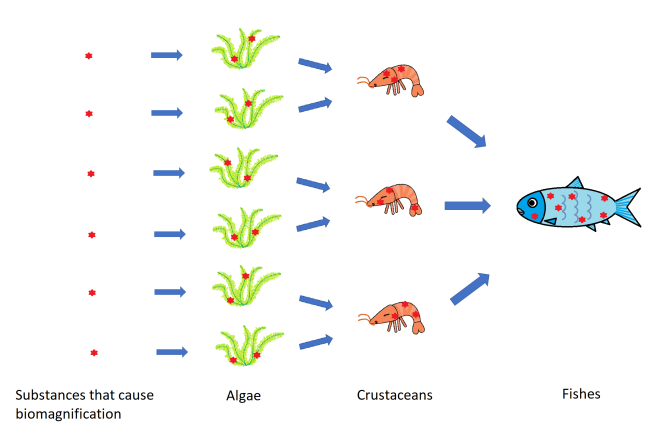Biomagnification and Radioactive Substances
Biomagnification and Radioactive Substances
HO Lok-ping and LEE Dexter
July 2022
Biomagnification generally refers to the process in which chemical substances (usually refers to harmful ones) in the natural environment gradually increase in concentration along the food chain. For biomagnification to be occurred, chemicals (including heavy metals, lipophilic organic compounds) are usually hard to be excreted or decomposed from the organism. As a result, the chemicals can accumulate stably in organisms for a long period of time and move up the food chain in progressively higher concentrations.
For example, algae in the ocean absorb a harmful chemical substance X, but the concentration is very low and does not inhibit the growth of algae. The crustaceans (such as shrimp) consume a lot of algae and X accumulates in their bodies because it cannot be effectively removed. In the same vein, when fishes eat crustaceans in a large amount, the concentration of X will further go up in the fishes. Eventually the concentration of X in the organisms at the top of the food chain will be significantly higher than the original environmental level, and even endanger the health of organisms.

Figure 1 Schematic diagram of biomagnification
Some of the heavy metals are also radionuclides, such as strontium-90. Once these radionuclides are absorbed by organisms, it is difficult to be metabolised and excreted from the body. Coupled with the long half-life of these radionuclides, they can stay in the organisms and cause negative effects for a long time. Therefore, continuous monitoring of whether radioactive substances in food may accumulate to dangerous levels due to biomagnification is an indispensable part of environmental radiation monitoring, and also an important work to ensure food safety and public health.
The Hong Kong Observatory regularly collects various types of terrestrial and aquatic food samples typical of the diet of the local population at major distribution points, wholesale markets and from enlisted suppliers, then carries out measurement of their radioactivity in the Radiation Laboratory at King's Park. The analysis results are published annually in the "Summary of Environmental Radiation Monitoring in Hong Kong" for download and review by the public.